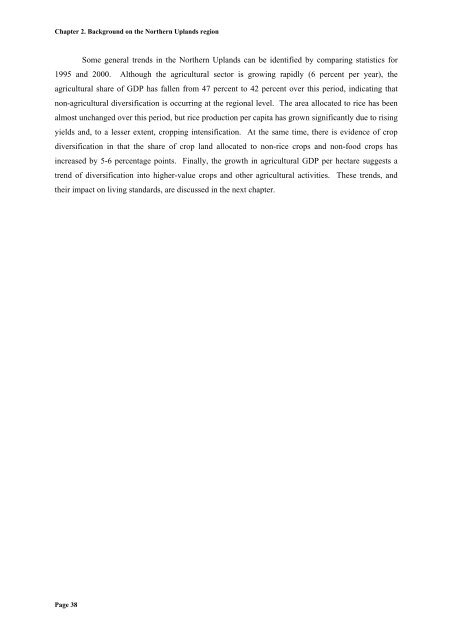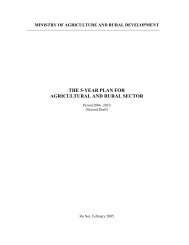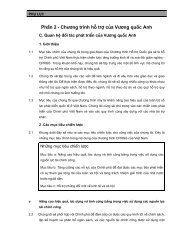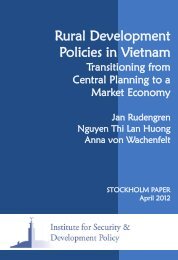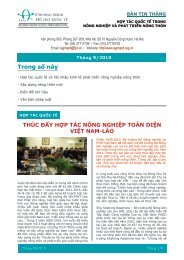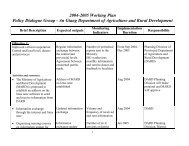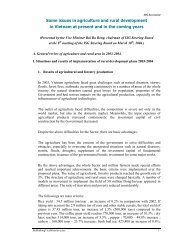- Page 1 and 2: Income Diversification and Poverty
- Page 3 and 4: Contact information: Nicholas Minot
- Page 5 and 6: Page iv
- Page 7 and 8: USA), with assistance from Dr. Finn
- Page 9 and 10: Chapter 4. Analysis of food demand
- Page 12 and 13: CHAPTER ONE INTRODUCTION 1.1 Introd
- Page 14 and 15: Chapter 1. Introduction into high-v
- Page 16 and 17: Chapter 1. Introduction In addition
- Page 18 and 19: Chapter 1. Introduction seemingly u
- Page 20 and 21: Chapter 2. Background on the Northe
- Page 22 and 23: Chapter 2. Background on the Northe
- Page 24 and 25: Chapter 2. Background on the Northe
- Page 26 and 27: Chapter 2. Background on the Northe
- Page 28 and 29: Chapter 2. Background on the Northe
- Page 30 and 31: Figure 2-3. Index of accessibility
- Page 32 and 33: Chapter 2. Background on the Northe
- Page 34 and 35: Figure 2-5. Main ethnic group in ea
- Page 36 and 37: Chapter 2. Background on the Northe
- Page 38 and 39: Chapter 2. Background on the Northe
- Page 40 and 41: Chapter 2. Background on the Northe
- Page 42 and 43: Chapter 2. Background on the Northe
- Page 44 and 45: Figure 2-7. Diversification into no
- Page 46 and 47: Figure 2-9. Diversification into no
- Page 50 and 51: Chapter 3. Patterns and trends in d
- Page 52 and 53: Chapter 3. Patterns and trends in d
- Page 54 and 55: Chapter 3. Patterns and trends in d
- Page 56 and 57: Chapter 3. Patterns and trends in d
- Page 58 and 59: Chapter 3. Patterns and trends in d
- Page 60 and 61: Chapter 3. Patterns and trends in d
- Page 62 and 63: Chapter 3. Patterns and trends in d
- Page 64 and 65: Chapter 3. Patterns and trends in d
- Page 66 and 67: Chapter 3. Patterns and trends in d
- Page 68 and 69: Chapter 3. Patterns and trends in d
- Page 70 and 71: Chapter 3. Patterns and trends in d
- Page 72 and 73: Chapter 3. Patterns and trends in d
- Page 74 and 75: Chapter 3. Patterns and trends in d
- Page 76 and 77: Chapter 3. Patterns and trends in d
- Page 78 and 79: Chapter 3. Patterns and trends in d
- Page 80 and 81: Chapter 3. Patterns and trends in d
- Page 82 and 83: Chapter 3. Patterns and trends in d
- Page 84 and 85: Chapter 3. Patterns and trends in d
- Page 86 and 87: Chapter 3. Patterns and trends in d
- Page 88 and 89: Chapter 3. Patterns and trends in d
- Page 90 and 91: Chapter 3. Patterns and trends in d
- Page 92 and 93: Chapter 3. Patterns and trends in d
- Page 94 and 95: Chapter 3. Patterns and trends in d
- Page 96 and 97: Chapter 3. Patterns and trends in d
- Page 98 and 99:
Chapter 4. Analysis of food demand
- Page 100 and 101:
Chapter 4. Analysis of food demand
- Page 102 and 103:
Chapter 4. Analysis of food demand
- Page 104 and 105:
Chapter 4. Analysis of food demand
- Page 106 and 107:
Chapter 5: Income Diversification f
- Page 108 and 109:
Figure 5-1. Location of provinces,
- Page 110 and 111:
Chapter 5: Income Diversification f
- Page 112 and 113:
Chapter 5: Income Diversification f
- Page 114 and 115:
Chapter 5: Income Diversification f
- Page 116 and 117:
Chapter 5: Income Diversification f
- Page 118 and 119:
Chapter 5: Income Diversification f
- Page 120 and 121:
Chapter 5: Income Diversification f
- Page 122 and 123:
Chapter 5: Income Diversification f
- Page 124 and 125:
Chapter 5: Income Diversification f
- Page 126 and 127:
Chapter 5: Income Diversification f
- Page 128 and 129:
Chapter 5: Income Diversification f
- Page 130 and 131:
Chapter 5: Income Diversification f
- Page 132 and 133:
Chapter 5: Income Diversification f
- Page 134 and 135:
Chapter 5: Income Diversification f
- Page 136 and 137:
Chapter 5: Income Diversification f
- Page 138 and 139:
Chapter 5: Income Diversification f
- Page 140 and 141:
Chapter 5: Income Diversification f
- Page 142 and 143:
Chapter 5: Income Diversification f
- Page 144 and 145:
Chapter 6. Diversification from the
- Page 146 and 147:
Chapter 6. Diversification from the
- Page 148 and 149:
Chapter 6. Diversification from the
- Page 150 and 151:
Chapter 6. Diversification from the
- Page 152 and 153:
Chapter 6. Diversification from the
- Page 154 and 155:
Chapter 6. Diversification from the
- Page 156 and 157:
Chapter 6. Diversification from the
- Page 158 and 159:
Chapter 6. Diversification from the
- Page 160 and 161:
Chapter 7. A Social Accounting Anal
- Page 162 and 163:
Chapter 7. A Social Accounting Anal
- Page 164 and 165:
Chapter 7. A Social Accounting Anal
- Page 166 and 167:
Chapter 7. A Social Accounting Anal
- Page 168 and 169:
Chapter 7. A Social Accounting Anal
- Page 170 and 171:
Chapter 7. A Social Accounting Anal
- Page 172 and 173:
Table 7.4: Structure of Marketed Su
- Page 174 and 175:
Chapter 7. A Social Accounting Anal
- Page 176 and 177:
Chapter 7. A Social Accounting Anal
- Page 178 and 179:
Chapter 7. A Social Accounting Anal
- Page 180 and 181:
Chapter 7. A Social Accounting Anal
- Page 182 and 183:
Chapter 7. A Social Accounting Anal
- Page 184 and 185:
Chapter 7. A Social Accounting Anal
- Page 186 and 187:
Chapter 7. A Social Accounting Anal
- Page 188 and 189:
Chapter 7. A Social Accounting Anal
- Page 190 and 191:
Chapter 8. Summary and conclusions
- Page 192 and 193:
Chapter 8. Summary and conclusions
- Page 194 and 195:
Chapter 8. Summary and conclusions
- Page 196 and 197:
Chapter 8. Summary and conclusions
- Page 198 and 199:
Chapter 8. Summary and conclusions
- Page 200 and 201:
Chapter 8. Summary and conclusions
- Page 202 and 203:
Chapter 8. Summary and conclusions
- Page 204 and 205:
Chapter 8. Summary and conclusions
- Page 206 and 207:
Chapter 8. Summary and conclusions
- Page 208 and 209:
References Page 200
- Page 210 and 211:
References Escobal, J. 2001. “The
- Page 212 and 213:
References Stone, R. 1981. Aspects
- Page 214 and 215:
Glossary Page 206
- Page 216 and 217:
Marshallian price elasticity: the r
- Page 218 and 219:
Page 210
- Page 220 and 221:
Appendix A: Supply response analysi
- Page 222 and 223:
Appendix A: Supply response analysi
- Page 224 and 225:
Appendix A: Supply response analysi
- Page 226 and 227:
Appendix A: Supply response analysi
- Page 228 and 229:
Appendix B: Interview Guidelines fo
- Page 230 and 231:
Appendix B: Interview Guidelines fo
- Page 232 and 233:
Appendix B: Interview Guidelines fo
- Page 234 and 235:
Appendix B: Interview Guidelines fo
- Page 236 and 237:
Appendix B: Interview Guidelines fo
- Page 238 and 239:
Appendix B: Interview Guidelines fo
- Page 240 and 241:
Appendix B: Interview Guidelines fo
- Page 242 and 243:
Page 234
- Page 244 and 245:
Appendix C: Interview Guidelines fo
- Page 246 and 247:
Appendix C: Interview Guidelines fo
- Page 248 and 249:
Page 240
- Page 250 and 251:
Appendix D: Constructing a standard
- Page 252 and 253:
Appendix D: Constructing a standard
- Page 254 and 255:
Appendix D: Constructing a standard
- Page 256 and 257:
Appendix E: Details of MacroSAM Con
- Page 258 and 259:
Appendix E: Details of MacroSAM con
- Page 260 and 261:
Appendix E: Details of MacroSAM con
- Page 262 and 263:
Appendix E: Details of MacroSAM Con
- Page 264 and 265:
Table A7.3: Ha Giang: Provincial Ma
- Page 266 and 267:
Table A7.7: Lang Son: Provincial Ma
- Page 268 and 269:
Table A7.11: Phu Tho: Provincial Ma
- Page 270 and 271:
Table A7.15: Son La: Provincial Mac
- Page 272:
JAPAN BANK FOR INTERNATIONAL COOPER


